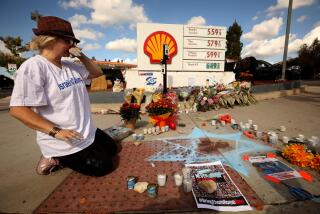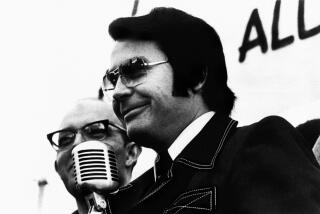Private Talks With God Go Public
Before dawn near Tucson, a group of Native American boys runs from the east to accompany the rising sun, as their way of calling on a higher power.
After a blizzard in Cincinnati, a team of born-again Christians shovels driveways to give thanks and praise.
And around the world, thousands of Hassidic Jews sign onto the Internet to commune with the most holy.
Unlikely as it may seem, these groups are all doing the same thing--praying together. What has long been a private pursuit for most people, outside of weekly worship service, is becoming a shared, even a social event in many quarters.
A growing curiosity about all religious traditions and a long established passion for every sort of club are stoking the enthusiasm. Yet, the unconventional packaging of so many groups has even the enthusiasts asking a basic question: What is prayer? Some wonder, too, whether certain types of prayer can be counterproductive.
Todayâs prayer groups are often finely focused. Groups form to pray a drug dealer out of town, or comfort those who are ill or persuade City Hall to put up a needed stoplight. There are prayer circles for members of a certain profession--athletes, business executives and postal carriers have their own gatherings.
Most of these gatherings are built on Christian traditions, but religions that worship several deities, or none, have their own parallel versions. And some groups are so spiritually eclectic they attract Buddhists, Catholics and Protestants all at once.
While there is a general sense that this is a burgeoning subculture, the number of people involved has yet to be tallied. But a growing body of research suggests that the movement is widespread.
* A recent Gallup International Institute poll shows that 62% of church attenders now meet in small groups where prayer is part if not all of the program. Most are born-again Christians, Protestants or Roman Catholics.
* A national survey conducted every year since 1981 by the National Opinion Research Center at Chicago University shows that 56% of adults now pray at least once each day. And 33% belong to a church-related group.
* In the past two years, some 20 new books about prayer have launched onto at least one bestseller list, regional or national. âIt used to be that books on prayer moved through religious conferences or church stores,â says Phyllis Tickle, religion editor at large for Publisherâs Weekly. âNow they get significant attention in the world of general retailing.â Increasingly, the most successful books offer practical instruction, not theory.
Extroverts can join the snow-blowers brigade in Cincinnati, a new twist on the ancient tradition of church processions. âWe go out in teams of two or three to serve the community,â says Pastor Steve Sjogren of the Vineyard Community Church, where âwalking prayerâ groups also clean gas station toilets in summer. âWe pray before, during and after the work.â As for the free service, Sjogren explains that itâs âa way of showing people what if feels like to be loved by God.â
Cerebral types might prefer a group like the one that meets at St. Edmundâs Episcopal Church in San Marino. Five women gather for an hour each week in silent contemplation, shared reflections and Scripture reading. âIt brings us closer to God and expands our spirituality,â says Jacqueline Miles, a psychologist.
Connecting with the transcendent or surprising strangers with acts of kindness are what draw prayer groups together in good times. Just as often, they form around a crisis.
âPeople were getting robbed, pistol-whipped, Maced,â says Lois Lesure, a Los Angeles postal worker. âThere were so many assaults, the carriers needed to petition a higher power.â And so they did, at the Greenmead Station in Los Angeles. For four years a small group of mail carriers prayed together for protection before they went out on their route.
Calling on a higher power was only part of the plan. They also got help from the police and the community. âThe combination was very effective,â Lesure says. Eventually, some members transferred to other stations and the group disbanded a few months ago. âWe believe our prayers were answered and we have so much work to do we put group prayer to the side,â explains Jacquelyn Scorza. âBut our individual prayers continue.â
For most social activists, prayer is not enough. âPrayer and action go hand in hand,â says Brian Kennedy, the Los Angeles area director of Prison Fellowship Ministries, which visits those in prison and helps ex-prisoners. âI can pray for a job all day long, but if I donât go look for one itâs not going to happen.â Kennedy oversees a team of 100 volunteers who stop every day at noon to pray for ex-prisoners.
Yet, there are those who argue that praying together is social action. âWe pray for the world and for all who have requested our prayers,â says Sister Sharana, a monastic who lives at the Self-Realization Fellowship International Headquarters in Los Angeles. Members of her tradition base their beliefs in both the Judeo-Christian Bible and the Hindu sacred book, the Bhagavad Gita.
Thursday evenings at Self-Realization Fellowship temples and centers around the world, members take part in a prayer circle, with silent meditation and spoken prayers. âWe donât promise anything,â Sister Sharana says of the prayers for the sick that are part of the weekly gatherings. âBut we have received thousands of letters of thanks.â
These groups and hundreds more point to a challenging question: For instance, how does anyone know prayer works? Often, a prayer is a plea or a petition. Prayer is also a way of giving praise and thanks. More broadly speaking, prayer is spiritual communion with God.
âIn our tradition, everything is prayer,â says Rupert Lopez, a professional teller of Native American stories who is based in Pasadena. Lopez remembers ârunning prayerâ as part of his life on the Papago (now the Tohono Oâodham Nation) reservation in Arizona, where he grew up. The tradition still continues, even though technically speaking, prayer groups are not part of Native American culture.
Buddhists do not consider prayer to be part of their tradition, either. Yet they too allow that there are parallels in their Zen meditation. âOur praying is to wish that all beings be well and happy,â says Venerable Ratnassara, president of the American Buddhist Congress in Los Angeles. âA loving-kindness meditation is Buddhist prayer.â
When prayer is spiritual communion, it may become virtual reality. âMy time online is definitely prayer time,â says Debra Farrington, who manages the Graduate Theological Union Bookstore in Berkeley. Farrington also subscribes to Ecunet, an online network of virtual prayer chapels and prayer meetings created 11 years ago by ministers of many denominations.
Hassidic Jews, using e-mail, grieve together over their renowned Rabbi Menachem Mendel Schneerson, who died in 1994. âJews can e-mail a prayer to the Lubavitch World Headquarters in Brooklyn, N.Y., and it will be read at the Rabbiâs grave site in Queens,â says Michael Levin. Levin, based in Santa Monica, includes several prayer Web sites in his new book, âThe Guide to the Jewish Internetâ (No Starch Press).
From a scientific point of view, prayer group power has no claim to better results than individual prayer, says Larry Dossey, a medical internist based in Santa Fe, N.M. âPeople pray together for social and psychological reasons. There is no empirical reason why people need to come together to be effective,â says Dossey, who studies prayer and the effects on physical health.
While he describes himself as an introvert who prefers to pray alone, Dossey acknowledges the growing interest in prayer groups and includes a list of them in his latest book, âPrayer is Good Medicineâ (Harper San Francisco, 1996).
Internet surfer Farrington, who is also part of a group that meets in person, finds strength in numbers. âItâs powerful to know that people are praying with us and for us,â she says. For her, a prayer group offers what a formal worship service can not. âIts power is its intimacy,â she says.
Can prayer backfire? âLately I have been looking at how prayer can be harmful,â Dossey says. He describes a man who was convinced his prayer would be answered and that his ailing wife would be cured. âThat didnât happen, and he became mentally deranged,â Dossey says. âWe can shoot ourselves in the foot if we have one answer in mind when we pray.â Rather than lobby for a particular outcome, he suggests asking that Godâs will be done.
Sunday mornings after services at St. Davidâs Episcopal Church in North Hollywood, five members of the congregation offer hands-on healing prayers. With such intense concentration that their palms turn hot to the touch, the group surrounds one person at a time and whispers prayers for healing--for a senior citizen in a wheelchair, for a middle-aged man with a relationship on the rocks.
Pastor Jose Poch, who trained the group and has practiced hands-on healing prayer for many years, says the outcome of prayer is never predictable. âThere are times when we pray and pray and see nothing change,â he says. âOther times, it takes a lot more than one time of prayer before we see emotional healing. All we can do is present the need before God. The credit is Godâs, and the result or lack of it is as well.â
More to Read
Sign up for our Book Club newsletter
Get the latest news, events and more from the Los Angeles Times Book Club, and help us get L.A. reading and talking.
You may occasionally receive promotional content from the Los Angeles Times.








